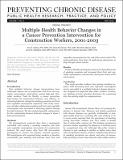| dc.contributor.author | Harley, Amy E. | |
| dc.contributor.author | Devine, Carol M. | |
| dc.contributor.author | Beard, Binta | |
| dc.contributor.author | Stoddard, Anne M. | |
| dc.contributor.author | Hunt, Mary K. | |
| dc.contributor.author | Sorensen, Glorian | |
| dc.date.accessioned | 2010-11-01T19:05:07Z | |
| dc.date.issued | 2010 | |
| dc.identifier.citation | Harley, Amy E., Carol M. Devine, Binta Beard, Anne M. Stoddard, Mary K. Hunt, and Glorian Sorensen. 2010. Multiple Health Behavior Changes in a Cancer Prevention Intervention for Construction Workers, 2001-2003. Preventing Chronic Disease 7(3). | en_US |
| dc.identifier.issn | 1545-1151 | en_US |
| dc.identifier.uri | http://nrs.harvard.edu/urn-3:HUL.InstRepos:4515105 | |
| dc.description.abstract | Introduction: Few multiple behavior change interventions have addressed tobacco use in conjunction with fruit and vegetable consumption, particularly among high-risk blue-collar workers. Tools for Health, a cancer prevention intervention for construction laborers, was effective in achieving behavior change for smoking cessation and fruit and vegetable consumption separately. This study examines whether addressing smoking and fruit and vegetable consumption was successful in achieving positive change for both behaviors. We also explored possible explanations for the relationship between behavior changes in these 2 behavioral domains. Methods: We retrospectively analyzed data from a randomized controlled trial testing a smoking cessation and fruit and vegetable consumption intervention for construction workers. We used survey data from 300 intervention participants to answer our primary research question: Did participants who reported being smokers at baseline successfully quit smoking and increase their fruit and vegetable consumption by the end of the intervention? We used qualitative data from 16 small group discussions to help interpret these results. Results: Tools for Health participants achieved substantial levels of smoking cessation and increased their fruit and vegetable consumption, concurrently, during the course of the intervention. Conclusion: This study provides evidence that pairing smoking cessation with increasing fruit and vegetable consumption can be successful in a multiple behavior change intervention designed for high-risk blue-collar workers. Further, our findings provide potential directions for examining why this pairing might be complementary. | en_US |
| dc.language.iso | en_US | en_US |
| dc.publisher | Centers for Disease Control and Prevention | en_US |
| dc.relation.isversionof | http://www.cdc.gov/pcd/issues/2010/may/09_0101.htm | en_US |
| dc.relation.hasversion | http://www.ncbi.nlm.nih.gov/pmc/articles/PMC2879987/pdf/ | en_US |
| dash.license | LAA | |
| dc.title | Multiple Health Behavior Changes in a Cancer Prevention Intervention for Construction Workers, 2001-2003 | en_US |
| dc.type | Journal Article | en_US |
| dc.description.version | Accepted Manuscript | en_US |
| dc.relation.journal | Preventing Chronic Disease | en_US |
| dash.depositing.author | Sorensen, Glorian | |
| dc.date.available | 2010-11-01T19:05:07Z | |
| dash.affiliation.other | SPH^Society Human Development and Health | en_US |
| dash.contributor.affiliated | Sorensen, Glorian | |


